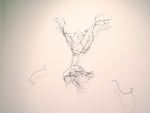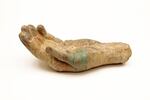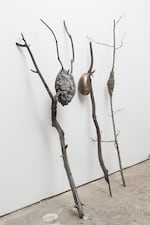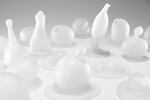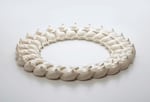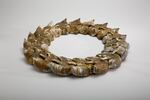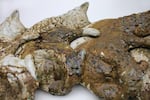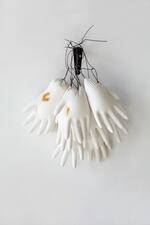
"My Friends", 2012. plaster, wire, hardware. 21 x 17 x 9 in Jensen: "Making plaster sculptures in my studio in New York, I started using my extra plaster. I'd flip my glove and fill the glove, tucking wire into it. It became an ongoing piece." The title is a reference to a novel by French author Emmanuel Bove.
Courtesy of Malia Jensen and Elizabeth Leach Gallery
Malia Jensen is one of the most engaged — and engaging — artists working in Oregon today. A gifted maker with a restless, unpretentious intellect, she mines the natural world to explore connection, environmental concerns, as well as the powers and limitations of the human form, and she's got a knack for embedding startling ideas in startlingly beautiful sculpture.
Jensen’s work takes center stage this month at Elizabeth Leach Gallery, where her newest show “Ground Effects” is on view. (The title is a nod to the custom after-market auto accessories like LED lights, spoilers and custom grills. Jensen calls it her homage to “the glamour in the underside, remaking what is below.”) She also just shipped off a large new work for a group show curated by Jens Hoffmann, “Animality: Animals and Art,” at the prestigious Marian Goodman Gallery, London.
Jensen’s been on a two-year tear since returning to Portland after eleven years in New York. We caught up with her at her studio, shortly after installing “Ground Effects.”
Q&A with Malia Jensen
April Baer: What’s the story of your return?
Malia Jensen: That was a confluence of a whole bunch of important details — finances being one. The loft I was living in became hard to hang onto. There were family things I needed to be back for. My house [in Portland] had been rented out for 10 years and needed some work. And New York was losing its appeal for me, and I needed to have my feet back on the earth. A lot of my work is about nature, and I had been outside of it for so long it was starting to be something I imagined in a hypothetical sense.
Baer: Trying to maintain connections in the art world and staying in touch with nature sounds like a balancing act.
Jensen: Yeah, I've always used elements of nature in a metaphoric context within the work — say, like the "Bubble Field" pieces that I made in Boston at Massachusetts College of Art and Design while I was still on the East Coast — they are in the show ["Ground Effects"]. They come from my fascination with the beginning and ending of cycles, or the inflating and collapsing of systems. They are about a mud-field-bubble-Yosemite experience, but they are really about creating and maintaining some kind of structure of faith.
Baer: Would it be fair to say that things were bubbling up in you at the time that you were working on this?
Jensen: Things are always bubbling up!
Baer: You’ve taken on a huge range of stuff in the past couple of years.
Jensen: When I got back I took to heart something I'd read in a list that Werner Herzog considered his "list for living" or "advice for living." Two things that I always remember are "Always carry bolt cutters," which I don't do, and "Send out all your dogs. One of them will return with prey." And this is what I felt like. For the past two years I've been trying to do this, trying to do that. I've been firing on as many circuits as an artist can, trying to figure out, how do you support yourself? How do you make a living? What situations do you create for yourself that you can use to sustain your personal ecosystem?
Baer: Can you give us an example of the "dogs" you send out?
Jensen: I had a class that I proposed to Barry Sanders at PCNA. It was a workshop class on anger. It was to be called "Discontent in the Age of Liking." I pitched myself as a restaurant designer for a friend who was opening a new place. I thought that the environment needs an ad campaign. Maybe I can do this. But inevitably what ended up working out was what I have always done, which is being an artist. So through a conversation with Stephanie Snyder I had a show at the Reed College Cooley Gallery in the Cases. It was a summation of a lot of work, a very autobiographical collection. I had a show at Wieden + Kennedy that was facilitated by some friends who worked there. That beaver ["Beaver Story", purchased by Dan Wieden in 2000] that in the W+K atrium has literally kicked down so many doors for me and set so many other productive things in motion for me in my art life. It was a real privilege to get to revisit that piece and contextualize it with a lot of other work. And there's the show at the Elizabeth Leach Gallery and the show with Marian Goodman in London.
Baer: How do you observe people reacting to these different layers in your work? Is there something that has to happen when someone looks at a work in that first moment?
Jensen: Yeah, I think that should happen. I hope the work is open to interpretation, but I feel pretty committed to making a piece that has an inarguable quality. There's a minimalism to the way I think about it. That's the way it's going to be ... I feel like I'm finding some kind of a central form.
Baer: Is getting [the idea] in your head into [physical] form a significant part of the time you spend in the studio, or is it an exploratory process of working with materials and seeing what evolves from that?
Jensen: I've always thought through my hands. What I hope for a viewer is that they arrive at the work and understand it at a gut level, and have that reaction move up to their head…It might start with an idea but I don't know how that's going to come about. For instance I'm looking at "Owl Carrying a Chicken Striking a Power Line (starting a forest fire)."
Baer: This is a wire sculpture from the show.
Jensen: I've carried this [concept] around for years, after hearing the story on the radio, maybe six years ago, about a forest fire. The news announcer said it was started by an owl carrying a chicken striking a power line. And I was so struck by this! I thought of it as a Western tableau, and about end times — where they might come from. We try to protect ourselves from terrorist threats or something else we might control. But really, it's just going to be an owl carrying a chicken.
Baer: This literal collision of something naturalistic with something very modern!
Jensen: Yeah. Completely. I had that thought in my head for years before I figured out how to make it. I tried to sketch it in clay, I tried to sketch it in plaster. Is it going to be a wall bronze? Is it gonna be a huge thing? I ended up, in a residency at Ucross in Wyoming where you are plunged into nature. I found this old fence wire and manipulated it into this sculptural piece. It came through my hands.
Baer: There’s a work in the show called “Lupe.” It’s a bronze casting of a wolf’s head. The wolf is chewing on something and, on approach, you realize, it’s the wolf’s own tail. How did that image come to you?
Jensen: That image comes from something that has been in the gestation period for a long time. I'm thinking about it as a metaphor for the cycle of success and failure. Just in the last few months the wolf — because it's succeeded in recovering — has been removed from the Endangered Species List. This means that you can shoot them again — a direct result of its own thriving! It's become for me a metaphor about self-destruction. As a people we are creating our own self-destruction by our thriving. We are just using resources we can't sustain. So what's a sustainable level of thriving? Western cultures are obviously pushing that limit.
Baer: It feels there’s a low-frequency buzz of anxiety running through the whole piece.
Jensen: Yeah, it's a metaphor. I'm celebrating a situation of failure and redemption, finding beauty in those moments that are so fragile and vulnerable. This heavy bronze wolf has a frailty to it … The inside of the wolf has a shape of the bronze that I'd taken out of the form when I cast it. It has a look like a cave. Daniel at the gallery says it's Plato's cave. It has a philosophical interior.
Baer: You had a work shown in Chicago called “Perfect Circle.” A more recent work you’ve just sent to London revisits the concept. Could you describe it for us?
Jensen: The original piece I made in 2008 was one cat form with a paw out on its side so that, in repetition it makes a complete ring with one paw lain over the side of the next cat. I was thinking of it originally as a minimalist piece that you might see at the Dia Foundation — a bastion of minimalist but earth-driven pieces: Robert Smithson, Carl Andre, Agnes Martin. I was invited to be in a show at Marian Goodman Gallery in London in November, curated by Jens Hoffmann, called "Animality: Animals and Art." I proposed to make the full-scale version of "Perfect Circle." This version is also ceramic but it's fired with glaze and concrete and glass. It's called "Perfect Circle, Imperfect." A cat circle in post-apocalyptic time. It's a bit dark, very earthen looking. It has runs of color in browns and rusts and dirt and metal. It's kind of a mess, but it's still redeemed by its continuous circle and the loving touch of each being onto the next.
Baer: The closeness of the community is still very much there.
Jensen: And that's a case of different people's reactions. Some will say, "How cute!" And some say, "That's horrifying." One piece can generate really polar responses.
Baer: What was it that made you want to mess up, or mess with, the perfect circle?
Jensen: Nothing is perfect! And in failure there's an opportunity for redemption. I was thinking about grief and the fact that it is often hand in hand with love. You have to have love in order to have that depth of feeling, of loss. There's a poignancy in this piece that I feel addresses concerns that I share with the rest of the concerned world. In the first piece it had a lighter sweetness to it that I felt like revisiting in darker times.
